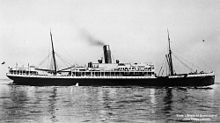Woermann line
The Woermann Line was a Hamburg shipping company . It existed from 1885 to 1941 and was one of the most important shipping companies in Africa at the time . From 1899 it had its company headquarters in the so-called Africa House in Grosse Reichenstrasse . For a time it was the largest private shipping company in the world.
history
The roots of the shipping company can be traced back to 1849, when the trading house Woermann sent the first sailing ship to West Africa. Five years later Woermann opened the first West African branch.
From the activities of the Woermann company on the West African coast, a coastal service of the Woermann shipping company emerged in the 1870s .

The African Steamship Actiengesellschaft Woermann-Linie was finally founded on June 15, 1885 by Adolph Woermann . The company began building a passenger and freight line service to the German colonies with two new ships. In 1890 the German East Africa Line was founded to expand the shipping area to other parts of Africa. In 1884 German South West Africa became a German protected area , after which the Woermann fleet was expanded.
During and after the Herero and Nama uprising in German South West Africa, today's Namibia , the Woermann Line doubled its fleet from 65,000 GRT in 1904 to around 130,000 GRT within three years. The line handled the traffic in support of the controversial military action with its own and chartered ships. In 1906 the Hamburg-Bremen Africa Line (HBAL) of the Hamburg company Menzell & Co. began to build a rival line. HBAL could not assert itself on its own, but was taken over by North German Lloyd before it threatened to collapse . Woermann then accepted an offer from Albert Ballin to establish a joint venture with HAPAG . From 1907 this received a quarter of the transport share of the West Africa voyage and took over eight surplus Woermann steamers. The German-East-Africa-Line also joined the joint service and in 1908 the Hamburg-Bremen Africa-Line joined the joint service in freight traffic to West Africa.
After the death of Adolph Woermann in 1911, Eduard Woermann succeeded him. In 1916 he sold the Woermann Line and the German East Africa Line to a consortium made up of HAPAG, Norddeutschem Lloyd and Hugo Stinnes . The Stinnes shares were taken over by HAPAG and NDL in 1921. In 1927 the German Africa Service Treaty of 1907 was continued for another 20 years and in the following years it was briefly found in calmer waters.
One year after the seizure of power by the Nazi Party in 1934 carried out a reorganization of the German shipping, in which the major shipping companies have been split. HAPAG and Norddeutsche Lloyd had to surrender their shares in the Woermann Line to the German Reich. In 1941 the Reich sold these shares to the cigarette manufacturer Philipp F. Reemtsma . He sold them to the shipowner John T. Essberger , who only continued the Deutsche Afrika-Linien in the post-war period , but did not continue to operate the Woermann-Linie. The painter and graphic artist Tom Hops went to sea as a paymaster for the Woermann Line for several years.
See also
literature
- Otto Mathies: Hamburg's shipping company 1814–1914 . Friederichsen Verlag, Hamburg 1924.
- Theodor Bohner : The Woermanns. On becoming German greatness. Publishing house Die Brücke zur Heimat, Berlin 1935.
- Dirk Bavendamm u. a .: West Africa venture. 150 years of C. Woermann. The history of a Hamburg trading house 1837–1987. Verlag Hanseatischer Merkur, Hamburg 1987, ISBN 3-922857-08-6 .
- Renate Hücking / Ekkehard Launer: Turn people into negroes. How the Woermann trading company developed in Africa. Galgenberg-Verlag, Hamburg 1986, ISBN 3-925387-08-0 .
- Hartmut Rübner: Concentration and Crisis in German Shipping. Maritime economy in the German Empire, in the Weimar Republic and in National Socialism. Hauschild Verlag, Bremen 2005, ISBN 3-89757-238-9 .
Web links
- Text by Dieter Engel
- Images on jaduland
- Woermannhaus on Afrika-online
- Vessel list on theshipslist (English)
- Early documents and newspaper articles on the Woermann line in the 20th century press kit of the ZBW - Leibniz Information Center for Economics .
Individual evidence
- ↑ Klaus J. Bade: Friedrich Fabri and Imperialism in the Bismarckian Age. Revolution - Depression - Expansion. (PDF; 3.0 MB) Freiburg i.Br. 1975, 2005 (2005 with a new foreword: Osnabrück), p. 315 (accessed on November 23, 2006)
- ↑ Page 3 in A lecture not given on the history of the Rotary Club Hamburg Steintor by Jürgen Blankenburg, 2005 (PDF file).




